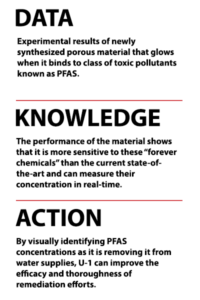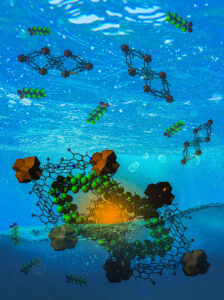A massive, worldwide effort is currently underway to remove a class of toxic pollutants known as PFAS from the environment. The United States Environmental Protection Agency has recently issued a drinking water regulation banning six such PFAS.
 These fluorine-based compounds were ubiquitous in industrial applications and consumer products for decades, thanks to their toughness and impermeability. However, the qualities that made them ideal for scratch-resistant coatings, waterproofing seals, and fire-fighting foam now makes them perniciously difficult to get rid of, earning them the moniker “forever chemicals.”
These fluorine-based compounds were ubiquitous in industrial applications and consumer products for decades, thanks to their toughness and impermeability. However, the qualities that made them ideal for scratch-resistant coatings, waterproofing seals, and fire-fighting foam now makes them perniciously difficult to get rid of, earning them the moniker “forever chemicals.”
Although many PFAS compounds have been banned, the effort to clean up existing contamination demands extensive R&D for both detection and remediation — the new EPA regulation earmarks up to $1 Billion for such efforts.
New research from the University of Utah’s John and Marcia Price College of Engineering has now introduced a new tool in this fight.
Led by Ling Zang, professor in the Department of Materials Science and Engineering, Rana Dalapati, a postdoctoral researcher in his lab, as well as other team members.
Published in the journal ACS Applied Materials & Interfaces, the study demonstrates the efficacy of the researcher’s new porous material, a metal-organic framework (MOF) that they have dubbed “U-1.”
Many existing chemicals and compounds readily bind to PFAS, either neutralizing its biological toxicity or allowing it to be more easily skimmed off contaminated water supplies. The latter type, known as sorbents, are part of the typical approach water treatment plants use to combat PFAS.
This approach is not without its limitations, however.
 “While these materials, like granular activated carbon, are capable of removing PFAS from water,” says Zang, “they give no indication of the actual quantity of PFAS captured, including whether any is captured at all.”
“While these materials, like granular activated carbon, are capable of removing PFAS from water,” says Zang, “they give no indication of the actual quantity of PFAS captured, including whether any is captured at all.”
“This uncertainty is a significant challenge, especially for water treatment facilities and remediation sites, as it is impossible to know exactly when these sorbents become saturated,” he says. “Once saturation is reached, a significant amount of PFAS could bypass the system untreated before fresh sorbent is added.”
Measuring the concentration of PFAS in a water sample is something that is typically done in a laboratory and is too slow to address the water treatment problem.
“As such,” says Dalapati, “there have been multiple attempts at designing molecules that can both adsorb PFAS and give a signal that it has done so.”
The researchers’ U-1 represents an advance over those attempts, thanks to its novel design. Earlier fluorescent MOF sorbents worked by starting in an “on” state; binding to a PFAS molecule would then break the fluorescent component of the MOF, turning it off.
“While effective in laboratory setting,” says Dalapati, “in practice, the background noise and false positives of the MOFs turning off prematurely made them unreliable.”
The design reported in Zang and Dalapati’s new paper works in reverse, with U-1’s fluorescence being turned on by the binding of PFAS. This approach provides a much more consistent signal; when the fluorescence in the contaminated water stabilizes, it means that the supply of U-1 has been used up — or that no more PFAS remains.
—###—
Fluorescence Turn-on Detection of Perfluorooctanoic Acid (PFOA) by Perylene Diimide-Based Metal–Organic Framework
Rana Dalapati, Matthew Hunter, Mostakim SK, Xiaomei Yang, and Ling Zang
ACS Applied Materials & Interfaces
https://doi.org/10.1021/acsami.4c03389
This work was sponsored by Gentex Corporation under award #10060686.
Dr. Zang is a member of the Board of Directors for Gentex Corporation, an industry-leading global supplier of innovative, advanced technology that optimize vision and enhance safety and convenience for automotive, aerospace, and commercial fire protection industries. Gentex Corporation has additional competencies in microelectronics, vision systems, software design, chemical development, glass processing and coatings, microphones, automated assembly, and more. U-1 was developed as part of a collaboration between Dr. Zang’s lab at the University of Utah and Gentex Corporation. The U’s Technology Licensing Office and Gentex are undergoing continued conversations for future collaboration and commercialization of the technology.